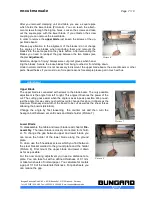
ne-cut-manual-e
Page 7 / 10
After you removed clamping unit and table you see a square pipe
which holds the lower blade (Picture 6). You can reach the attach-
ment screws through the big top holes. Loosen the screws and take
out the square pipe with the lower blade. If you unfasten the screw
coupling you can remove the lower blade.
In order to remove the
upper blade
just loosen the screws of the up-
per blade beam.
Please pay attention to the alignment of the blades: do not change
the angles of the blades when regrinding them and remount the
blades into the same position they were before. After remounting the
blades you need to readjust the gap between the two blades (see
chapter
Adjustment
).
Attention, danger of injury! Always were cut proof gloves when hand-
ling the blades. Secure the loose blades from being touched or from falling down.
Under normal conditions it is not necessary to dismount the upper blade beam, the eccentric axis or other
parts. Nevertheless if you must do so for repair reasons for example please get in touch with us.
Adjustment
Upper Blade
The upper blade is connected with screws to the blade beam. The only possible
adjustment is the angle from left to right. This angles influences the power of the
cut. The cutting goes easier when the angle is as aslope as possible. We pre-ad-
just the angle this way and you should avoid to change this since it influences the
maximum thickness and width of the board to be cut as well as the shear forces
attacking the boards (distortion).
Change the angle by first loosening the counter nut and then turn the
hexagon bolt between eccentric axis and blade holder (Picture 7).
Lower Blade
To disassemble the table and lower blade read chapter
Dis-
assembly
. The lower blade is closely connected to its hold-
er. To change the gap between upper and lower blade you
can move the holder of the lower blade along the ground
plate.
To do so use the 5 headless screws which you find between
the steel bracket welded to the ground plate and the holder
(Picture 8). First mount the upper blade and lower it down
as far as possible.
For the now coming adjustment you need a distance tem-
plate. You can take foil with a defined thickness of 0.1 mm
or take two sheets of normal paper. You calculate for metals
a gap of 1/10 of the materials thickness. For pcb sheets you
can reduce the gap.
Bungard Elektronik GmbH & Co. KG, Rilkestraße 1, 51570 Windeck – Germany
Tel.: +49 2292 / 9 28 28-0, Fax: +49 2292 / 9 28 28-29
, E-mail: [email protected]
Picture 6
Picture 8
Picture 7




























